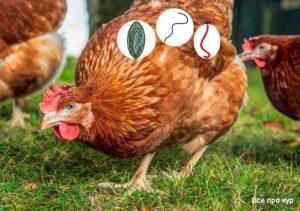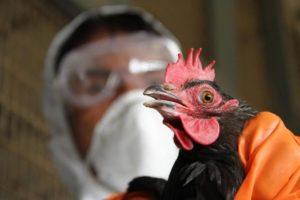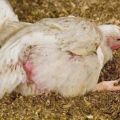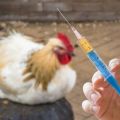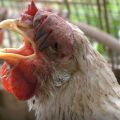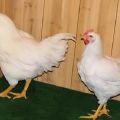Description of broiler diseases and causes, symptoms and treatment methods
There are a large number of broiler diseases, each with a different characteristic. They are able to provoke the appearance of various violations. Sometimes dangerous diseases are the cause of paralysis and even death. The timely detection of the disease and the choice of tactics for treating pathology helps to prevent such problems.
What diseases do broilers have and how can they be treated?
Young birds are most often susceptible to diseases, since at the stage of formation and development, the body is most sensitive to adverse factors.

Dyspepsia
This pathology is characterized by a violation of the functions of the digestive organs. Symptoms often appear in day old chicks due to irregularities in the diet. The body of young birds is highly sensitive and needs careful control of the feed quality.
The reasons for the problems include improper nutrition and violation of the temperature regime. Diarrhea is considered a key manifestation of the disease. Chickens lose appetite and mobility.
To cope with the disease, the chickens are given a 0.03% soda solution. They should introduce acidobulon cultures into their diet. The menu should contain fermented milk products, herbs, vitamins, feeds that are easy to digest, meat and bone meal.

Bronchopneumonia
This disease is very dangerous for broilers. Sick birds become unkempt, lose their appetite, and their body weight decreases. Often, birds begin to cough.
To cope with the pathology, it is recommended to take 1.5 cups of soda ash and mix with 3 liters of hot water. Add bleach solution - 1 glass to 7 liters of water. Leave the product to stand and add water to get 20 liters. Treat the house with the resulting mixture.
For the treatment of chickens, it is permissible to use Norfloxacin or Penicillin. From folk remedies, tinctures of nettle and ginseng are suitable.

Hypovitaminosis
Deficiency of vitamins and minerals leads to the development of various diseases. Lack of vitamin A is accompanied by loss of appetite, developmental arrest, weakness and decreased physical activity. As the disease progresses, digestion is disturbed and the nervous system is damaged.
Lack of B vitamins causes disturbances in the functioning of the digestive organs, the occurrence of conjunctivitis, developmental problems, apathy. Treatment is carried out with vitamin supplements.
The diet of chicks should include greens, meat and bone meal, sprouted grains.

Marek's disease
This disease is provoked by a viral infection that is present in the DNA. It causes paralysis of the goiter and damage to the nervous system. Symptoms of pathology include a change in the color of the iris, loss of appetite, weakness, pain in the legs, deformation of the limbs and neck.
There are no effective drugs for the treatment of Marek's disease. The virus persists for a long time in the feathers of birds. Therefore, when the first signs of an illness are detected, the bird has to be slaughtered.

Coccidiosis
This infection is caused by infection with eimeria tenella. The risk of developing the disease increases in warm and humid weather. Coccidia enters the body through water, bedding, food. When infected, the digestive organs and the nervous system are affected.
1-2 days after infection, diarrhea, loss of appetite, weakness appear. Feathers become disheveled and the skin becomes pale. Chickens die after 4 days.
To cope with the disease, drugs such as Koktsisan, Baykoks are used. Birds need to be isolated and medications added to food and water for 4 days.

Pullorosis
This is one of the varieties of salmonellosis. The causative agent of the disease is Salmonella pullorum-gallinarum. The risk of developing the disease increases in conditions of unsanitary conditions and high humidity in the chicken coop.
Diarrhea with white impurities becomes a key symptom of the disease. Birds become depressed, lose their appetite, and experience severe thirst. The disease is characterized by general weakness, respiratory failure, and an increase in temperature.
To combat the disease, antibacterial drugs are used - Biomycin and Sulfadimezin.
It is recommended to isolate infected birds. The rest of the individuals should be treated with antibiotics and antiviral agents.

Newcastle disease
With the development of the disease, birds develop coughing, apathy, and impaired coordination of movements. They become sickly and lose weight. Infected individuals often trample in one place.
As it is a contagious disease, it is recommended to isolate the affected birds. At the same time, there are no effective remedies for pathology.

Colibacillosis
Escherichia coli, which is present in chicken feces, leads to the development of pathology. Infected masses can enter water or food, resulting in all chickens being affected.
The first manifestations of the disease include diarrhea, apathy, and a blue tint of the beak. Young chickens are most often affected. Violation of sanitary conditions becomes the cause of pathology.
It is possible to cope with the disease only at the initial stage. For this, antibiotics are used - Enronit, Lexofon. If all livestock are infected, the birds have to be disposed of. Their meat is forbidden to be eaten.

Salmonellosis
This is an infectious pathology that can spread by airborne droplets from healthy birds to sick birds. The disease is characterized by lacrimation, loss of appetite, diarrhea, growth retardation, and swelling of the legs.
If salmonellosis is detected, the whole livestock should be given Levomycetin. Sometimes there are no symptoms of the disease, so it can be difficult to identify it. Usually, the first symptoms appear several days after infection.
For the prevention of the disease, it is worth using mineral supplements. Sometimes the drug Enroflon is used.

Aspergillosis
This is a fungal disease that affects the respiratory system. This causes wheezing and coughing. Pathogens enter the embryos through the shell. Prevention of fungal infections in the bedding of chickens will help to avoid problems. Places near feeders and drinking bowls should be systematically cleaned.
With the development of the disease, chickens become lethargic and lose their appetite. For treatment, it is worth contacting a veterinarian who will select the optimal drugs.

Rickets
This disease is caused by a deficiency of calcium, vitamin D, phosphorus.This is due to disturbances in the diet, rare walking of birds and close housing. Pathology is accompanied by a softening of the beak, gait disturbance and bouncing when walking, developmental delay, ruffled feathers.
In broiler chickens, the disease may appear on the 8-10th day of life. With the acute nature of the disease, there is a curvature of the bones, a distortion of the body, an increase in the head against the background of a small body.
To cope with rickets, it is recommended to make adjustments to the diet of birds. At the same time, it is worth increasing the amount of grains and herbs. It is also worth giving the chicks fish and meat and bone meal, chalk, limestone. Vitamin complexes are prescribed from medicines.

Bird flu
This is an infectious pathology that is transmitted to domestic chickens from wild birds. When infected, the motor activity of birds decreases, body temperature increases, thirst appears, and a loss of appetite is observed.
The mucous membranes turn red, diarrhea occurs, feathers become ruffled. With the development of pathology, the respiratory and digestive organs suffer. Depending on the form of the disease, death is possible in 10-100% of cases.
If signs of pathology are detected, it is worth notifying the local veterinarian. There are no effective treatments for avian influenza today. The meat of sick birds should not be eaten. Therefore, they are slaughtered and burned.

Chicken pox
Pathology is viral in nature. You can get infected from sick birds, insects, rodents. The infection enters the body through damaged areas and mucous membranes. There are several forms of the disease:
- Cutaneous - considered the easiest. In this case, red warts appear on open areas of the skin.
- Diphtheria is the most acute variety. In this case, the respiratory organs, esophagus, larynx, mucous membranes suffer. Chickens cannot eat food. In 50% of cases, death occurs.
- Mixed - in this case, the virus infects the skin and mucous membranes.
Only the mildest form of the disease can be treated. In this case, infected individuals are isolated and given a solution of Furacilin or Anfluron. It is recommended to treat the house with formaldehyde and disinfect. Healthy birds should be vaccinated immediately.

Sinusitis
This disease is spreading rapidly. If infected individuals are identified, they must be immediately isolated. Chickens can be infected from wild birds. Dust or objects containing a virus also cause a problem.
The first symptoms of sinusitis are yawning, wheezing, and coughing. In addition, chickens develop swelling of the eyelids, fluid from the eyes and nose, cramps, sneezing, feathers on the head stick together.
If you do not start therapy in a timely manner, there is a risk of chronicity of the process. At the same time, birds lag behind in development. Antibiotics are used to treat sinusitis. The most effective drug is Terramycin. It is administered by aerosol or put in feed. Chlortetracycline also helps to achieve good results. The agent is mixed into food or water.

What if the disease could not be recognized?
If you suspect a disease, you should immediately show the chickens to the veterinarian. Only a doctor will be able to make an accurate diagnosis, after laboratory tests.
Based on the results of the research, the specialist will prescribe medications and select preventive measures for the rest of the livestock.
Preventive actions
The accumulation of chickens and the rapid change of generations lead to the appearance of various infections. To avoid problems, it is worthwhile to disinfect the equipment, drinkers and feeders in a timely manner. All these devices are recommended to be thoroughly washed and treated with special solutions.
The premises need systematic ventilation. It is recommended to whitewash and dry them regularly. Particular attention should be paid to the quality of the feed.It is strictly forbidden for birds to feed acidic or moldy foods.

Use liquid additives periodically and monitor water quality. Compliance with the temperature, illumination, and humidity conditions is also important.
There are many diseases of broilers that can lead to their death. Each pathology is characterized by certain manifestations. To cope with the problem, it is recommended to make the correct diagnosis in a timely manner and choose an adequate treatment.
